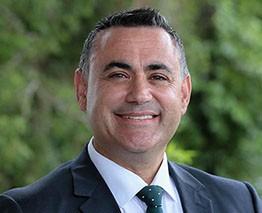Message from the Ministers
The freight industry is the lifeblood of the NSW economy - worth $66 billion to our State economy. From big businesses to farmers, retailers to consumers, we all rely on our goods getting to us in a safe and efficient manner.
The NSW Freight and Ports Strategy (PDF, 33.54 MB) released in 2013 was the first long-term freight vision to be produced for NSW, which drove targeted investment in both metropolitan and regional transport networks. All freight transport operators who use our roads, our rail networks, our ports or our airports have felt the benefits the 2013 strategy has delivered. Projects such as WestConnex, the Cargo Movement Coordination Centre (CMCC) and upgrades to the Pacific, Newell and Great Western Highways are all fine legacies of that strategy.
But with the NSW freight task set to grow by 28 per cent by 2036, a continued focus is required on the freight sector.
The NSW Freight and Ports Plan 2018-2023 is a call to action for government and industry to work together to make our freight system more efficient, more accessible, safer and more sustainable for the benefit of producers, operators, customers and communities across NSW.
Over the next five years, we will:
Drive economic growth and deliver capacity enhancements
- Invest in new and improved infrastructure, including, new port infrastructure at Glebe Island, the Coffs Harbour Bypass and completion of the Pacific Highway, upgrades to Local and Regional Roads, Regional Rail Network improvements and improving the capacity of east-west movements over the Great Dividing Range.
- Deliver more than $5 billion in committed key infrastructure projects for freight in NSW. These include $543 million towards Fixing Country Roads, $400 million towards Fixing Country Rail, $15 million towards the Fixing Country Rail pilot, $21.5 million towards the Main West rail line, $500 million towards the Sydney Airport Road upgrade, $400 million towards Port Botany Rail Line duplication, $1171 million towards the Coffs Harbour Bypass and $2.2-$2.6 billion towards Sydney Gateway.
- We will harmonise regulation to make NSW a better place to do business and improve data sharing to assist industry decision making.
- Moving more with less, we will increase the road to rail share of rail freight at Port Botany to 28 per cent by 2021. We will increase the length of appropriate State Roads accessible by priority restricted access vehicles to further open up the NSW road freight network. By identifying, protecting and zoning land for intermodal terminals we will protect land needed for vital freight and logistics operations. Further, by assisting with necessary road and rail link extensions, we will achieve more effective local planning for freight.
- We will work with industry to improve the efficiency of urban freight, including, through the continued operation of Goulburn St Courier Hub, which has the potential to reduce kerbside usage by 4,600 hours per year and reduce 26,000 vehicle kilometres travelled in the Eastern Harbour City CBD.
Increase efficiency, connectivity and access
Time is money – acknowledging that every hour moving freight has a cost the Plan sets a target toensure 90 per cent of peak travel on key road routes is on time. This will be achieved by delivering smart motorways helping to improve travel times and reliability through targeted congestion programs. We will support Port Botany technologies to improve productivity including, a tracking system for containers using sensors with barcodes or licence plate recognition software and trials of drones to investigate reasons for delays in moving goods within the Port Botany precinct. We will also investigate major pipeline projects in Western Sydney, the Hunter and at Port Kembla to reduce the need for dangerous goods to be transported by road.
Improve safety and sustainability
Doing more together, by working closely with industry to facilitate greater sharing of data to provide benefits across supply chains. This will involve exploring new technology to make road and rail networks more efficient. We will assist local councils by providing information which helps to identify key freight corridors, assessing bridge and road capacity, understanding the safety features of Performance Based Standard (PBS) vehicles and their impact on reducing truck movements to help increase capacity on the network. We will improve rail efficiency by providing greater separation of passenger and freight movement on the rail network and new and improved intermodal terminals to increase the utilisation of the rail freight network. We will target a 30 per cent reduction in fatalities and serious injuries involving heavy or light trucks (against a three year average 2008 to 2010 baseline) through the delivery of a new Heavy Vehicle Safety Strategy in line with our commitments in our Road Safety Plan 2021.
This Plan is the result of significant consultation, and brings together policy makers, producers, operators, regulators and government to enable more co-ordinated and better freight planning. It includes firm targets to achieve faster, more efficient and higher capacity networks to remain competitive, support jobs and deliver economic growth across NSW.
Working together to implement this Plan, NSW can continue moving and be confident that we will meet the freight task of the future.


